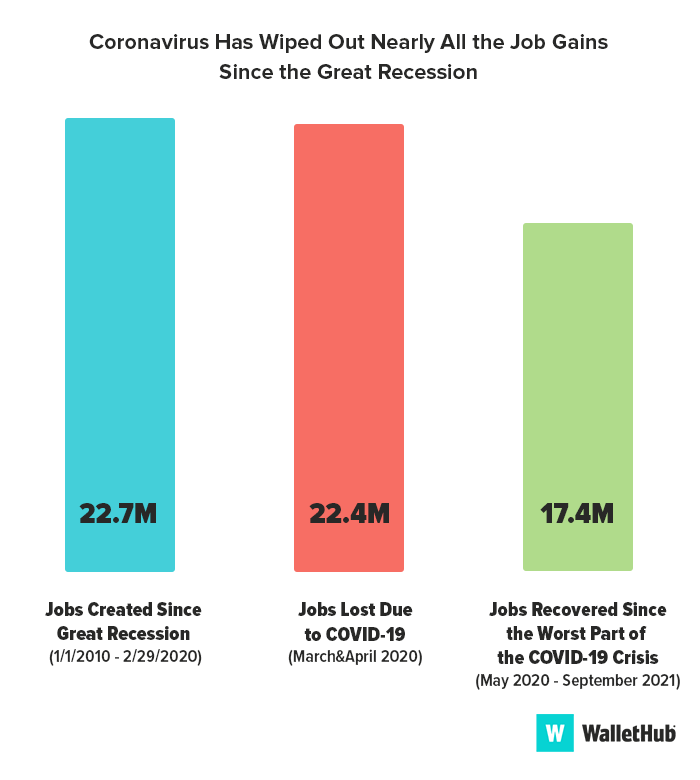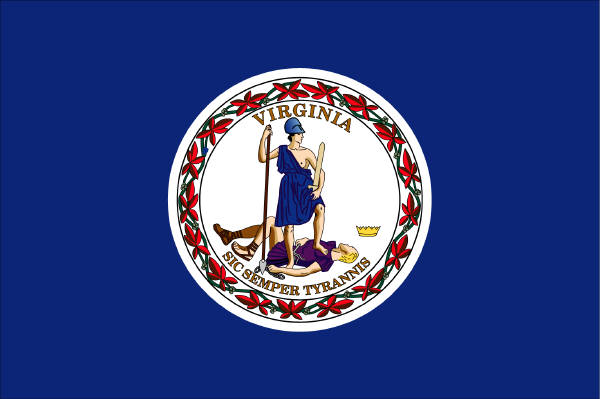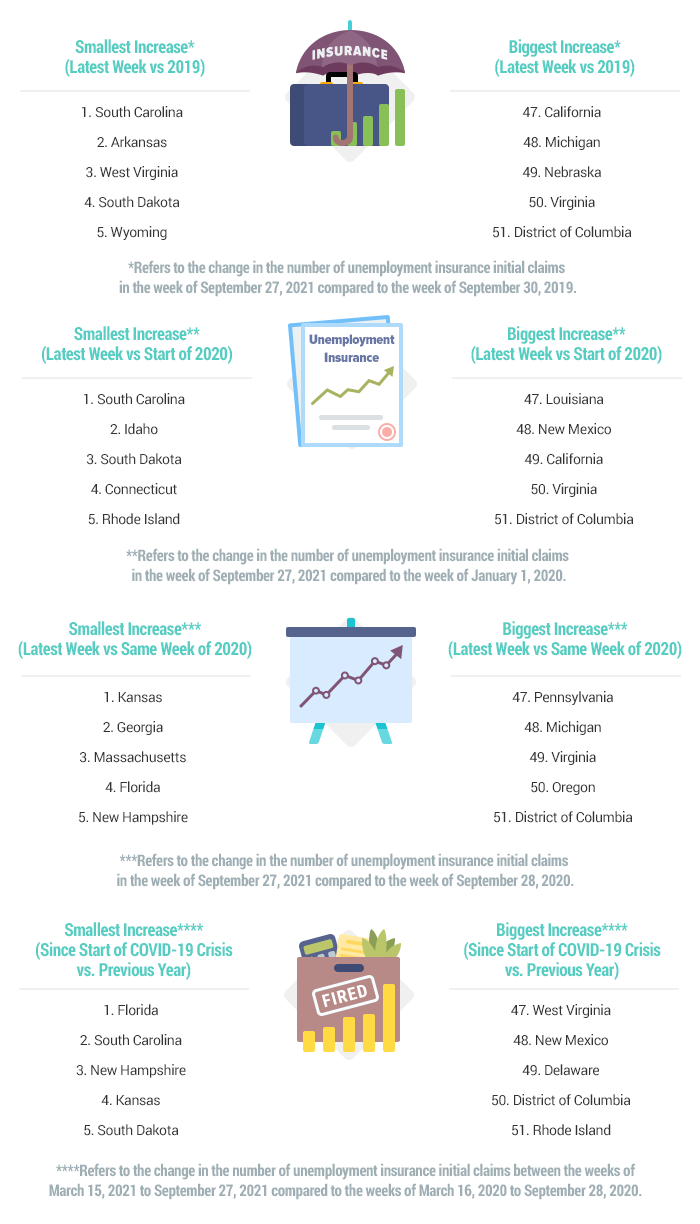The U.S. is making significant progress in the fight against COVID-19 with the distribution of the vaccine, and this has been reflected in the job market, as new unemployment claims decreased week-over-week on September 27. There are currently 8.4 million Americans unemployed due to the COVID-19 pandemic in total, though, and it’s important to look at some key stats for the latest week to get the full picture:
- There were 326,000 new unemployment claims nationwide, which is a lot fewer than the 6.1 million during the peak of the pandemic (a 95% reduction).
- 18 states had unemployment claims last week that were lower than before the pandemic: South Carolina, Arkansas, West Virginia, South Dakota, Wyoming, Montana, Kansas, Missouri, Iowa, Nevada, Illinois, Washington, New Hampshire, Arizona, North Dakota, Delaware, Maryland and New Jersey.
- Surprisingly, Virgina had unemployment claims last week that were the second worst in the country. Virginia also claims the 40th spot for states that have recovered the quickest since th ebeginning of the pandemic.
To identify which states’ workforces are experiencing the quickest recovery from COVID-19, WalletHub compared the 50 states and the District of Columbia based on changes in unemployment claims for several key benchmark weeks.
Main FindingsDetailed FindingsCoronavirus Job Losses vs. Great RecessionStates That Ended Benefits Early vs. Unemployment ClaimsRed States vs. Blue StatesAsk the ExpertsMethodology
Main Findings
States Whose Unemployment Claims Are Recovering the Quickest
| State | Recovered Most Since Last Week | Recovered Most Since Start of COVID-19 Crisis |
|---|---|---|
| South Carolina | 1 | 2 |
| Arkansas | 2 | 11 |
| Kansas | 3 | 4 |
| South Dakota | 4 | 5 |
| West Virginia | 5 | 47 |
| Montana | 6 | 27 |
| New Hampshire | 7 | 3 |
| Missouri | 8 | 28 |
| Illinois | 9 | 42 |
| Washington | 10 | 8 |
| Wyoming | 11 | 32 |
| North Dakota | 12 | 16 |
| Delaware | 13 | 49 |
| Nevada | 14 | 23 |
| Massachusetts | 15 | 24 |
| Maryland | 16 | 35 |
| Iowa | 17 | 17 |
| Rhode Island | 18 | 51 |
| Idaho | 19 | 38 |
| Georgia | 20 | 10 |
| New Jersey | 21 | 21 |
| New York | 22 | 19 |
| Mississippi | 23 | 14 |
| Arizona | 24 | 7 |
| North Carolina | 25 | 6 |
| Colorado | 26 | 30 |
| Connecticut | 27 | 33 |
| Florida | 28 | 1 |
| Oklahoma | 29 | 34 |
| Kentucky | 30 | 13 |
| Vermont | 31 | 44 |
| Maine | 32 | 12 |
| Utah | 33 | 45 |
| Indiana | 34 | 20 |
| Pennsylvania | 35 | 29 |
| Ohio | 36 | 41 |
| Wisconsin | 37 | 39 |
| Texas | 38 | 37 |
| Louisiana | 39 | 15 |
| Minnesota | 40 | 9 |
| Alaska | 41 | 43 |
| Oregon | 42 | 46 |
| Alabama | 43 | 36 |
| Tennessee | 44 | 31 |
| New Mexico | 45 | 48 |
| Hawaii | 46 | 25 |
| California | 47 | 26 |
| Nebraska | 48 | 18 |
| Michigan | 49 | 22 |
| Virginia | 50 | 40 |
| District of Columbia | 51 | 50 |
Rank 1 = Most Recovered
Detailed Findings
| State | Change in Unemployment Claims (Latest Week vs. 2019)* | Change in Unemployment Claims (Latest Week vs. Start of 2020)** | Change in Unemployment Claims (Latest Week vs. Same Week of 2020)*** | Change in Unemployment Claims (Since Start of COVID-19 Crisis vs. Previous Year)**** |
|---|---|---|---|---|
| South Carolina | -50.95% | -84.51% | -76.43% | -91.16% |
| Arkansas | -47.29% | -61.45% | -81.89% | -84.59% |
| Kansas | -26.86% | -52.25% | -93.22% | -90.24% |
| South Dakota | -37.84% | -71.11% | -74.10% | -89.56% |
| West Virginia | -45.91% | -57.74% | -66.24% | -62.43% |
| Montana | -27.92% | -50.03% | -77.62% | -77.77% |
| New Hampshire | -17.55% | -50.29% | -83.53% | -91.13% |
| Missouri | -23.69% | -65.01% | -70.77% | -76.76% |
| Illinois | -18.28% | -41.27% | -80.92% | -70.02% |
| Washington | -18.04% | -50.16% | -73.04% | -85.61% |
| Wyoming | -30.73% | -54.38% | -60.21% | -75.18% |
| North Dakota | -14.42% | -68.06% | -68.25% | -82.23% |
| Delaware | -8.70% | -52.00% | -76.35% | -50.25% |
| Nevada | -18.72% | -15.59% | -75.94% | -78.82% |
| Massachusetts | 2.90% | -52.40% | -84.72% | -78.41% |
| Maryland | -7.95% | -38.10% | -77.58% | -74.85% |
| Iowa | -20.69% | -61.47% | -58.79% | -81.93% |
| Rhode Island | 4.55% | -69.73% | -78.69% | -35.85% |
| Idaho | 3.65% | -75.04% | -75.03% | -72.54% |
| Georgia | 18.75% | -66.29% | -87.18% | -85.28% |
| New Jersey | -4.93% | -52.10% | -69.00% | -79.76% |
| New York | 15.27% | -69.43% | -78.63% | -80.56% |
| Mississippi | 2.51% | -16.81% | -75.69% | -83.09% |
| Arizona | -16.53% | 0.61% | -60.44% | -85.78% |
| North Carolina | 0.03% | 7.38% | -75.75% | -88.05% |
| Colorado | 1.63% | -17.77% | -66.23% | -76.47% |
| Connecticut | 0.95% | -70.33% | -49.53% | -75.17% |
| Florida | 7.20% | 40.95% | -84.61% | -91.50% |
| Oklahoma | 12.41% | -35.37% | -67.09% | -75.04% |
| Kentucky | 11.36% | -47.90% | -52.59% | -83.33% |
| Vermont | 15.41% | -52.65% | -46.86% | -68.30% |
| Maine | 42.03% | -64.64% | -65.45% | -83.48% |
| Utah | 16.14% | -21.81% | -53.90% | -67.35% |
| Indiana | 30.05% | -21.63% | -65.51% | -80.27% |
| Pennsylvania | 25.02% | -51.63% | -33.47% | -76.65% |
| Ohio | 44.07% | -17.53% | -52.43% | -70.02% |
| Wisconsin | 54.49% | -54.65% | -51.08% | -71.83% |
| Texas | 29.98% | 48.68% | -56.57% | -72.89% |
| Louisiana | 50.38% | 77.86% | -78.09% | -82.75% |
| Minnesota | 62.43% | -37.75% | -53.18% | -85.51% |
| Alaska | 57.13% | 37.10% | -63.83% | -69.56% |
| Oregon | 24.57% | -35.21% | -1.32% | -67.26% |
| Alabama | 79.10% | -22.91% | -52.35% | -73.82% |
| Tennessee | 61.01% | 50.36% | -53.98% | -76.23% |
| New Mexico | 55.27% | 84.23% | -57.75% | -57.47% |
| Hawaii | 90.85% | 32.60% | -52.39% | -78.20% |
| California | 104.67% | 85.75% | -69.84% | -77.85% |
| Nebraska | 168.93% | -6.28% | -68.40% | -80.71% |
| Michigan | 122.89% | 14.81% | -14.33% | -78.89% |
| Virginia | 316.58% | 205.77% | -10.10% | -71.56% |
| District of Columbia | 714.58% | 712.89% | 137.11% | -47.65% |
*Refers to the change in the number of unemployment insurance initial claims in the week of September 27, 2021 compared to the week of September 30, 2019.
**Refers to the change in the number of unemployment insurance initial claims in the week of September 27, 2021 compared to the week of January 1, 2020.
***Refers to the change in the number of unemployment insurance initial claims in the week of September 27, 2021 compared to the week of September 28, 2020.
****Refers to the change in the number of unemployment insurance initial claims between the weeks of March 15, 2021 to September 27, 2021 compared to the weeks of March 16, 2020 to September 28, 2020.
Coronavirus Job Losses vs. Great Recession

Source: Bureau of Labor Statistics.


